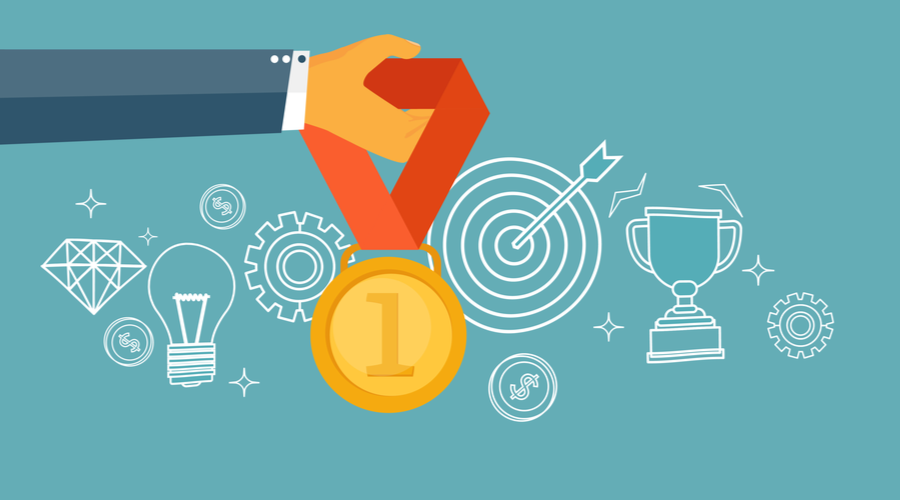More and more research is confirming that what employees need in the workplace is engagement. According to a Gallup poll, only one-third of employees are engaged with their job. Lack of engagement is often cited as one of the top reasons for employee dissatisfaction and low productivity. Employees who are disengaged “will usually show up to work and do the minimum required but will quickly leave their company for a slightly better offer,” according to the poll.
To right this wrong, a new management strategy has started to crop up at major companies across the US: gamification.
Gamification is when you apply the principles of a game — concrete goals, prizes, and the ability to feel like a winner — to the tasks in your workplace. Gamification provides an incentive for employees to achieve more and helps them visualize the progress they’ve made. Through gamification, you can inspire your employees to be more excited and engaged with their work.
How Gamification Works
When you gamify your workplace, you encourage your employees to take part in behaviors that make them more productive, more skilled, and more informed. Here’s what you need to know about gamifying your pharmacy.
Set measurable goals
For gamification to work, you have to outline specific actions that will lead to specific outcomes. While “establish a closer relationship with the community,” might be a good general goal, the actions your employees should take to achieve that goal aren’t immediately clear.
To help in the gamification process, you can return to the SMART goals you have set for your pharmacy. These are specific, achievable goals with measurable outcomes that you hope to achieve within a limited amount of time.
For the community building example, gamifying your goal might look a little something like this:
You create a specific list of actions that employees can take that will help the pharmacy achieve a better relationship with your community — things like attending a health fair on behalf of the pharmacy or fostering a connection with another local business. Put a time limit of a year on the goal, and encourage employees to partake in as many of those pre-determined community-building activities as they can within the time frame.
Establish rewards
Another crucial part of the gamification process is the incentives. A good incentive doesn’t have to be an all-expenses-paid trip to Hawaii, but it should be enough to get employees excited about participating.
Recognition on its own can be a powerful motivator, and if employees know they could be lauded as “Employee of the Month,” the title alone could be enough to encourage them to participate.
But in the long term, tangible incentives can be even more effective. Things like an extra day of PTO, a gift certificate for a local restaurant, or a bonus on their paycheck awarded in combination with public recognition can be even more motivating to play the game.
Find a way to acknowledge everyone
Gamification is designed to have a “winner,” but it shouldn’t also have losers.
In addition to awarding the person who made the most impact during the game, you should acknowledge other individual and collective accomplishments.
When you reach a milestone toward your goal, celebrate it in the pharmacy, and call attention to employees who are going above and beyond, even if they aren’t currently the frontrunner.
How to Implement Gamification
Gamification is particularly well suited to workplace tasks like onboarding and professional development.
A recent Talent LMS study found that 83 percent of people who participated in a gamified training program felt motivated, and only 10 percent felt bored. You can use this to your advantage during the onboarding process when new employees have lots of new information to learn.
Without gamification, reading through manuals and learning new rules can be tedious. With gamification, it becomes engaging.
Break up your onboarding process into smaller lessons with quizzes and a scoring system. Most people want to do well when they are first starting a job, so they will pay extra attention so they can prove themselves on a quiz, and the knowledge will be more likely to stick.
You can also apply gamification to your employees’ professional development. Encourage them to seek out continuing education or participate in online courses that will make them a better retailer. Reward the employees who seek out professional development opportunities with points and call out their extra efforts at the end of the year.
Employees who previously might have skipped out on these opportunities will want to get into the game, and you’ll be rewarded with a more skilled and capable workforce.
Editor’s picks
The Best (and Only) Way to Maximize Wholesaler Rebates
10 Revenue Ideas That Don’t Involve DIR Fees and PBM Reimbursements
Is Owning a Pharmacy Profitable?
How NOT to Implement Gamification
Gamification can be a huge motivator, but if done wrong, it can be dispiriting.
Your pharmacy has all different types of employees, and a gamified productivity goal will look different for a pharmacist than it will for a front-end clerk. Instead of trying to compare apples to oranges and create individualized gamification goals for every employee, it’s better to stick to higher-level goals that everyone can participate in at the same level, no matter what their job title is.
Gamification can also have unintended negative consequences when employees become more results-focused than process-focused. If, for example, you want to improve your customer service and decide to reward employees who inspire good online reviews, you may inadvertently incentivize your employees to pressure patients into giving reviews instead of actually improving their customer service skills.
Before you decide on what “game” you want to play in the pharmacy, think hard about the ways it could potentially be exploited.
And ultimately, while some people love gamification, there will inevitably be employees who would rather not play, which is why gamification should be optional. If employees want to play to win for a Visa gift card or an extra day of PTO, that’s great, but respect employees who just want to do their duties as assigned without the bells and whistles.
An Independently Owned Organization Serving Independent Pharmacies
PBA Health is dedicated to helping independent pharmacies reach their full potential on the buy side of their business. The member-owned company serves independent pharmacies with group purchasing services, expert contract negotiations, proprietary purchasing tools, distribution services, and more.
An HDA member, PBA Health operates its own NABP-accredited (formerly VAWD) warehouse with more than 6,000 SKUs, including brands, generics, narcotics CII-CV, cold-storage products, and over-the-counter (OTC) products.
Want more pharmacy business tips and advice? Sign up for our e-newsletter.















